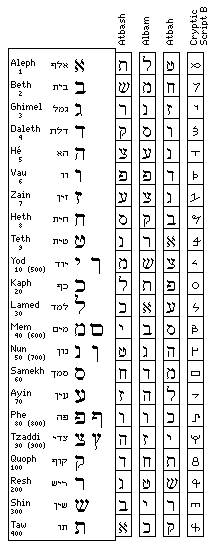The most obvious way, perhaps, of taking text and concealing it from the prying eyes of those who don't know your secret is by replacing each letter by something else, like this:
ABCDE FGH IJKL MNO PQRST UVW XYZ ----- --- ---- --- ----- --- --- $7+Q@ ?)/ 2X3: !8J 9%6*& 15= (;4
which turns
Please send me some money
into
9:@$*@ *@8Q !@ *J!@ !J8@;
This is called substitution, and ciphers based on this principle date back to ancient times.

For example, the diagram on the left illustrates several cipher alphabets used by the ancient Hebrews. Three of them are based on arrangements of the alphabet according to a definite pattern, and these patterns can be illustrated in terms of the 26-letter alphabet used by the English language by showing what the equivalent substitutions are in that alphabet:
Atbash: A B C D E F G H I J K L M ------------------------- Z Y X W V U T S R Q P O N Albam: A B C D E F G H I J K L M ------------------------- N O P Q R S T U V W X Y Z Atbah: A B C D J K L M E S T U V ------- ------- - ------- I H G F R Q P O N Z Y X W |
Note that all three of these are reciprocal, in that if one letter becomes another letter, then that other letter becomes the original letter in turn.
The illustration also contains other information. The numerical value of each letter is given below the name of the letter, and the original Hebrew form of the name of the letter is also shown to the right. Also, Cryptic Script B, an alphabet used in the writing of part of the Dead Sea Scrolls is shown (albeit imperfectly; the symbol for Shin is only known to be used for one of the two values of that letter, as indicated by dots, and an additional special-purpose character is not shown.)
The other method of concealing a message is called transposition, which was also used in ancient times, at least by the Spartans with the scytale, a baton around which a leather belt could be wound, so that a message could be written on the belt, crossing from one loop to the next, so that it could only be read while the belt was so wound.
In transposition, instead of replacing letters with something else, the letters of a message are moved around, so that they aren't written down in order.
Skip to Next Section
Table of Contents
Main Screen
Home Page